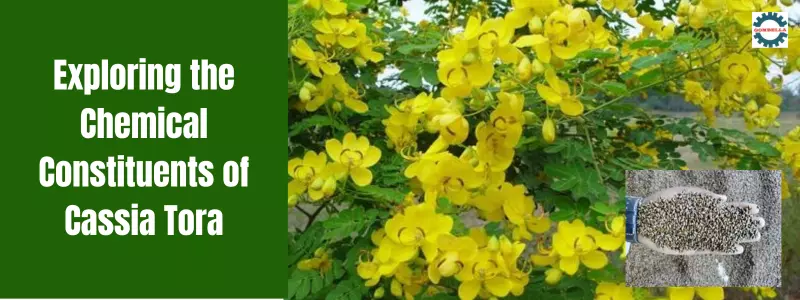-
-
Suite 1, Floor 2, Wing C, Alhaji Adenekan Plaza, Okota Road, Isolo, Lagos State, Nigeria
Blog Details

14
DecUnveiling Nature’s Chemistry: Exploring the Chemical Constituents of Cassia Tora
In the intricate world of botanical wonders, Cassia Tora emerges as a treasure trove of chemical constituents, offering manufacturers a rich source of natural compounds with diverse applications. Gombella Integrated Services Limited, a trusted exporter of Cassia tora seeds, proudly presents this in-depth exploration into the chemical constituents of Cassia Tora, shedding light on the fascinating and beneficial elements that make up this botanical marvel.
Introduction:
Contents
Gombella Integrated Services Limited extends an invitation to manufacturers, beckoning them into the realm of Cassia Tora’s chemistry. This blog post delves into the chemical constituents of Cassia Tora, providing a comprehensive understanding of the natural compounds that contribute to its diverse applications across industries.
1. Anthraquinones:
At the heart of Cassia Tora’s chemical profile lies anthraquinones, a group of naturally occurring compounds with distinctive properties. These compounds contribute to the plant’s therapeutic potential, offering manufacturers in the pharmaceutical and herbal industries a valuable source for creating formulations aimed at promoting health and well-being.
2. Flavonoids:
Cassia Tora boasts a rich content of flavonoids, a class of compounds celebrated for their antioxidant properties. These natural antioxidants play a crucial role in protecting cells from oxidative stress. Manufacturers exploring natural ingredients for their products can leverage the flavonoids in Cassia Tora, adding a touch of natural protection to formulations in various industries.
Read about ” Cassia Tora Seed Tea”
3. Polysaccharides:
Polysaccharides form a significant part of the chemical makeup of Cassia Tora. With their complex structure, these compounds contribute to the plant’s mucilaginous nature. This quality makes Cassia Tora a sought-after ingredient in the food and pharmaceutical industries, where its polysaccharide content aids in thickening and stabilizing various formulations.
4. Saponins:
Saponins, another group of compounds found in Cassia Tora, exhibit foaming and emulsifying properties. This makes them valuable for applications in the cosmetic and personal care industries, where manufacturers seek natural ingredients to enhance the texture and performance of their products. Cassia Tora’s saponins contribute to the creation of gentle and effective formulations.
5. Proteins and Amino Acids:
Cassia Tora seeds are a source of proteins and amino acids, the building blocks of life. The presence of these essential nutrients makes Cassia Tora a potential ingredient in the food and nutritional supplement industries. Manufacturers aiming to enhance the nutritional profile of their products can explore the protein and amino acid content of Cassia Tora seeds.
6. Essential Oils:
Cassia Tora contains essential oils that contribute to its aromatic profile. While not present in large quantities, these oils add a subtle fragrance to the plant. Manufacturers in the cosmetic and fragrance industries may find the essential oils of Cassia Tora to be a unique and natural addition to their formulations.
7. Lipids:
Lipids, including fatty acids, are part of the chemical composition of Cassia Tora seeds. While not the primary focus, the lipid content adds to the overall nutritional profile of the seeds. Manufacturers exploring plant-based sources of lipids
can consider Cassia Tora seeds as an ingredient with potential applications in the food and dietary supplement industries.
8. Triterpenoids:
Triterpenoids, a class of compounds with diverse biological activities, contribute to the pharmacological potential of Cassia Tora. These compounds are of interest to manufacturers in the pharmaceutical industry, where natural sources of bioactive compounds are continually sought after for the development of therapeutic formulations.
9. Minerals:
Cassia Tora seeds contain a variety of minerals, including calcium, phosphorus, and iron. These minerals contribute to the nutritional content of the seeds, making them a valuable ingredient for manufacturers creating products that aim to address dietary deficiencies and promote overall health.
10. Alkaloids:
Alkaloids are present in trace amounts in Cassia Tora, adding to the plant’s chemical diversity. While not the primary focus, the presence of alkaloids contributes to the overall chemical makeup of Cassia Tora seeds. Manufacturers in the pharmaceutical industry may find these compounds intriguing for their potential biological activities.
Conclusion on the Chemical Constituents of Cassia Tora:
In conclusion, the chemical constituents of Cassia Tora unveil a complex and diverse profile that captivates industries seeking natural and beneficial ingredients. Gombella Integrated Services Limited takes pride in offering manufacturers access to the rich chemistry of Cassia Tora through its export of seeds. As industries continue to prioritize natural solutions, Cassia Tora stands as a botanical resource, providing a spectrum of compounds that contribute to the creation of innovative and health-promoting formulations.
The exploration of Cassia Tora’s chemical constituents is a testament to the intricate relationship between nature and industry. Gombella Integrated Services Limited remains committed to supplying manufacturers with a source of botanical richness, inviting them to harness the chemical wonders of Cassia Tora for the advancement of their products and the well-being of consumers worldwide.
Author's Details
gombella
Other posts by gombella